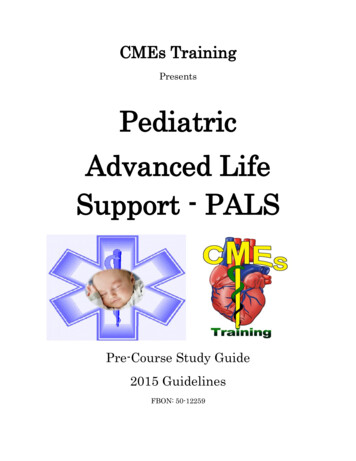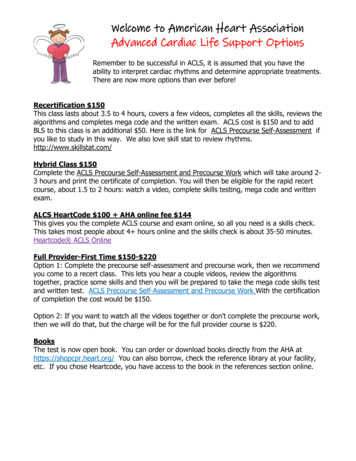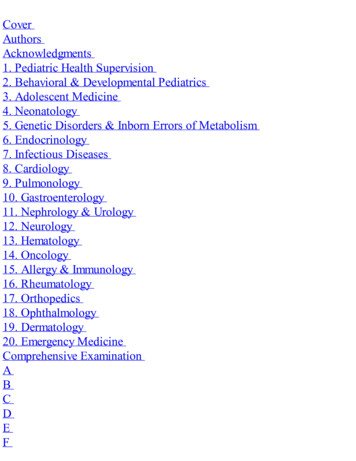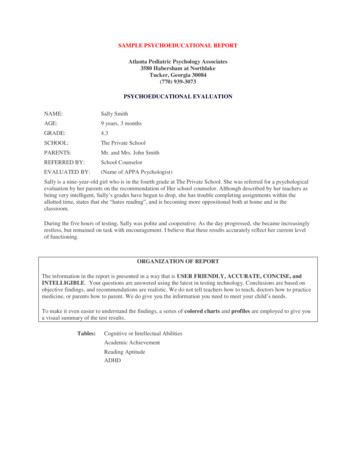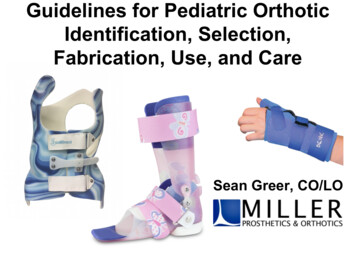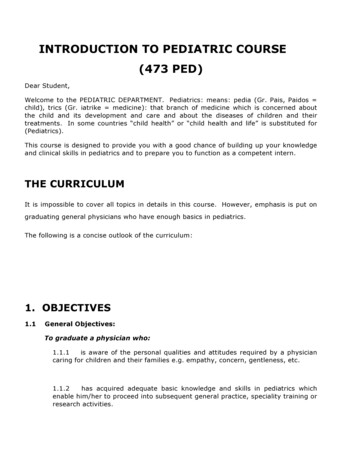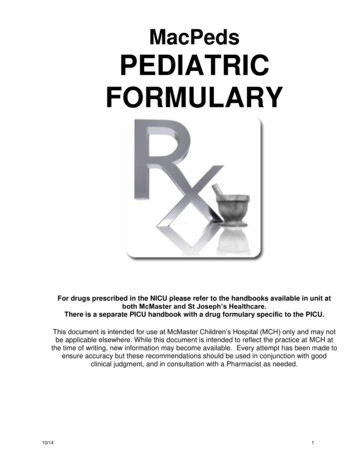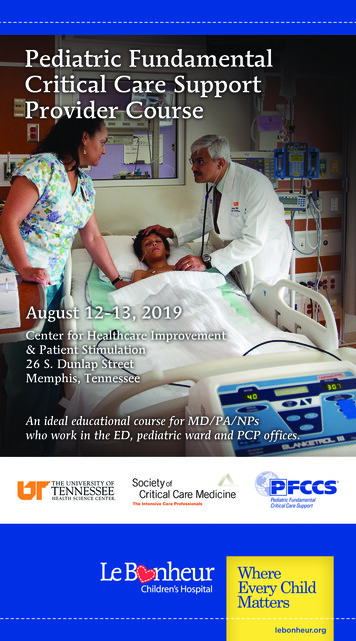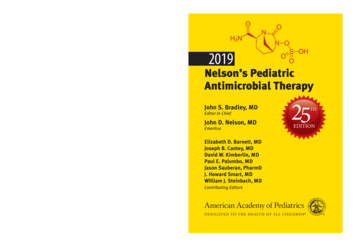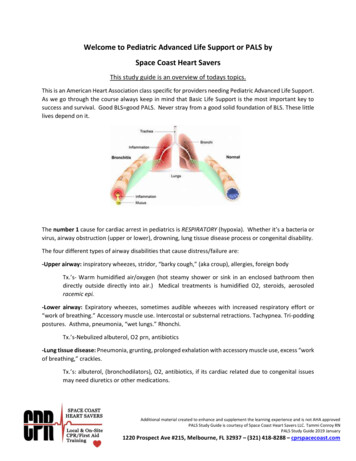
Transcription
Welcome to Pediatric Advanced Life Support or PALS bySpace Coast Heart SaversThis study guide is an overview of todays topics.This is an American Heart Association class specific for providers needing Pediatric Advanced Life Support.As we go through the course always keep in mind that Basic Life Support is the most important key tosuccess and survival. Good BLS good PALS. Never stray from a good solid foundation of BLS. These littlelives depend on it.The number 1 cause for cardiac arrest in pediatrics is RESPIRATORY (hypoxia). Whether it’s a bacteria orvirus, airway obstruction (upper or lower), drowning, lung tissue disease process or congenital disability.The four different types of airway disabilities that cause distress/failure are:-Upper airway: inspiratory wheezes, stridor, “barky cough,” (aka croup), allergies, foreign bodyTx.’s- Warm humidified air/oxygen (hot steamy shower or sink in an enclosed bathroom thendirectly outside directly into air.) Medical treatments is humidified O2, steroids, aerosoledracemic epi.-Lower airway: Expiratory wheezes, sometimes audible wheezes with increased respiratory effort or“work of breathing.” Accessory muscle use. Intercostal or substernal retractions. Tachypnea. Tri-poddingpostures. Asthma, pneumonia, “wet lungs.” Rhonchi.Tx.’s-Nebulized albuterol, O2 prn, antibiotics-Lung tissue disease: Pneumonia, grunting, prolonged exhalation with accessory muscle use, excess “workof breathing,” crackles.Tx.’s: albuterol, (bronchodilators), O2, antibiotics, if its cardiac related due to congenital issuesmay need diuretics or other medications.Additional material created to enhance and supplement the learning experience and is not AHA approvedPALS Study Guide is courtesy of Space Coast Heart Savers LLC. Tammi Conroy RNPALS Study Guide 2019 January1220 Prospect Ave #215, Melbourne, FL 32937 – (321) 418-8288 – cprspacecoast.com
-Disordered control of breathing-Tumors, stroke, brain injuries, seizures, congenital abnormalities,uncontrolled endocrine disorders (DKA from diabetes).Tx.’s- O2, PPV (if severe), diabetic or seizure meds, possible intubation.Epiglottitis is considered a very serious upper airway problem. If severe enough, can cause an upperairway obstruction due to swelling and difficulty swallowing and breathing. This is considered a medicalemergency and these patients need CT scan to rule out abscesses, broad spectrum antibiotics, most likelyadmission for respiratory control and observation.Get a good history and assessment right off the bat. SAMPLE:S- Signs/symptomsA-AllergiesM-MedicationsP-Pertinent Past Medical HistoryL-Last Oral IntakeE-Events leading up to the Illness or InjuryAdditional material created to enhance and supplement the learning experience and is not AHA approvedPALS Study Guide is courtesy of Space Coast Heart Savers LLC. Tammi Conroy RNPALS Study Guide 2019 January1220 Prospect Ave #215, Melbourne, FL 32937 – (321) 418-8288 – cprspacecoast.com
Pediatric Weight and DosingThe most recommended way to calculate drug dosages in an emergent situation is with the BroselowTape. If one is unavailable, the Handtevy Method is a quick way some pre-hospital personnel use todetermine pediatric weight in kg. As you can see by the diagram of the hand each finger represents a yearin age. One year starts at the thumb at 10kg and goes up 5 kg per finger every other year (1, 3, 5, 7, 9).Most pediatric medications are measured in mg/kg. This is quick helpful tool to help in calculations.Additional material created to enhance and supplement the learning experience and is not AHA approvedPALS Study Guide is courtesy of Space Coast Heart Savers LLC. Tammi Conroy RNPALS Study Guide 2019 January1220 Prospect Ave #215, Melbourne, FL 32937 – (321) 418-8288 – cprspacecoast.com
BROSELOW TAPE/CHART for quick reference to pediatric weight, dosages, and equipment size. The colorson the tape correlate to a pediatric crash cart.A 4 year old child would be 16-18 kg. A 2 year old child is 12-14 kg.The most accurate way to calculate pediatric weights from pounds to kilograms is divide the weight inpounds by 2.2. Ex: a 32 pound child would be 14.5 kg.One last way to figure out a weight quickly is to take their weight in pounds and divide by two. Thensubtract 10%. Ex: a 22 pound baby would be 22/2 11 11-10% (is 1.1) so the child is appx. 10 kg. Ex: childis 48 pounds 48/2 24 24-10% (2.4) 21.5 kg.Practice and find out whatever way is the most accurate and efficient way for you.Epinephren is 0.01 mg/kg it comes in a 10 ml syringe of 1/10:000. If the child weighs 10 kg then it wouldbe calculated as:0.01mg/kg x 10kg 0.1 mg of epi. A 10ml syringe has I mg of epi. You only need 0.1mg so you would drawup 1 ml.ShockThe definition of shock in inadequate tissue perfusion. This can be the delivery of glucose or oxygen toperipheral issues or organs. This can lead to life-threatening emergencies. There can be several reasonsfor this and different types of shock. What we, as medically trained personnel, need to be concerned withis compensated vs. uncompensated shock. Is it reversible? What can we do to prevent it from gettingworse? What is the cause? What interventions do they need now?Compensated Shock is earlier of the two. Blood pressure is still within the normal range. THIS IS THEBIGGEST PREDICATE FOR COMPENSATED VS. UNCOMPENSATED SHOCK. Their heartrate will be elevated.This is their normal compensatory mechanism from the body to try and re-perfuse and deliver thenecessary glucose and oxygen back to the deprived tissues.Uncompensated Shock is later. Blood pressure is low. End organ damage is usually present. Patient isusually unresponsive and not tolerating life saving measures. Their O2 sats are low, respirations are notadequate (rate or quality), and they could have cool extremities and a warm core from shunting.Primary Assessment: -ExposureAdditional material created to enhance and supplement the learning experience and is not AHA approvedPALS Study Guide is courtesy of Space Coast Heart Savers LLC. Tammi Conroy RNPALS Study Guide 2019 January1220 Prospect Ave #215, Melbourne, FL 32937 – (321) 418-8288 – cprspacecoast.com
Types of Shock:Hypovolemic: caused be too little of volume. Blood or fluids. Dehydration. Third spacing. Trauma.Vomiting and diarrhea. It causes intravascular fluid loss. This has decreased cardiac filling that results indecreased preload and afterload. Their cardiac output is poor and perfusion is inadequate. Poor oralintake is a main cause. Hemorrhage is another contributor from trauma (penetrating trauma, externalhemorrhage or blunt trauma with internal hemorrhage), burns, DKA (diabetic keto acidosis and polyuria),as well as environmental exposures and peritonitis.Distributive: Massive vasodilation. *SEPTIC* Neurogenic (high level spinal cord injuries). Anaphylaxis.Peripheral vasodilation occurs flushing fluids to the extremities and a decrease in systemic vascularresistance. Pediatrics that may have a high grade fever or are hypothermic may have septic shock. Infantsor neonates younger than three months can present with septic shock without a fever.Cardiogenic: Cardiomyopathy, Arrhythmias. This causes decreased cardiac output due to decreasedsystolic function. Some neonates with hepatomegaly or heart murmur may have a ductal abnormalityresulting in cardiogenic shock. You should not be as aggressive with fluid therapy on these patients. Theyshould get 5-10ml/kg over 10-20 min.Obstructive: Tamponade, Pulmonary Embolism. Tension Pneumothorax. This is the least common inpediatrics. It’s caused by an acute obstruction in the cardiac pulmonary blood flow.Additional material created to enhance and supplement the learning experience and is not AHA approvedPALS Study Guide is courtesy of Space Coast Heart Savers LLC. Tammi Conroy RNPALS Study Guide 2019 January1220 Prospect Ave #215, Melbourne, FL 32937 – (321) 418-8288 – cprspacecoast.com
The most common is septic, then hypovolemic, distributive and then cardiogenic. In septic shock one ofthe main ways to improve a child’s odds is with antibiotics within the first hour. Normally pediatrics cancompensate to increased oxygen demand by increasing the heart rate and cardiac stroke volume. Whena child is in shock there becomes some type of impairment to not allow this to happen. Lactate isaccumulated and hypoxic injuries occur.To quickly assess a patient for alertness you can use the acronym AVPU:A-AlertV-Responds to verbal stimuliP-Responds to Painful stimuliU-UnresponsiveLook at your patient!! Are they lethargic? Poor oral intake? Decreased urinary output? Poor feeding?Tachypnea? Look at their chest and abdomen for paradoxical breathing. Retractions. Increased work.Poor interaction. They might be tachycardic, altered mental status, weak peripheral pulses (LOW BLOODPRESSURE), CAPILLARY REFILL TIME OF GREATER THAN 2 SECONDS.Treatment of ShockThe goal is to re-perfuse the tissues and organs. The number one distinction between compensated anduncompensated shock is BLOOD PRESSURE. Re-perfuse with blood, oxygen and fluids. Their mentation,respiratory effort, blood pressure, heartrate, respiratory rate, and capillary refill should all return tonormal parameters. Make sure their urine output 1ml/kg/h, have normal BG levels, and other labs returnto normal parameters. Make sure the patient has a secured airway before attempting reperfusiontherapy. Listen to lung sounds and assess for hepatomegaly before, during, and after fluid administration.If they develop rales or hepatomegaly then discontinue fluid resuscitation. 20 ml/kg of isotonic solutionshould be administered as a bolus if the child does not have any heart defects or renal impairment. Thiscan be repeated up to three times over a period of 15 minutes. If the child remains in shock, you shouldsuspect hemorrhaging. If the child is hypoglycemic you can infuse dextrose water according to theirweight and Broselow recommendation. Refer to the Broselow for continued recommendation if pressorsare indicated to increase blood pressure and get the patient to a pediatric ICU.Additional material created to enhance and supplement the learning experience and is not AHA approvedPALS Study Guide is courtesy of Space Coast Heart Savers LLC. Tammi Conroy RNPALS Study Guide 2019 January1220 Prospect Ave #215, Melbourne, FL 32937 – (321) 418-8288 – cprspacecoast.com
Intraosseous AccessThe most significant reason for administering an IO is in CARDIAC ARREST. These patients are technicallydead and need immediate intervention (access for fluids and meds and shock if indicated by their rhythmif present). You should familiarize yourself with insertion technique and process.Contraindications: trauma, fracture, burns, infections (cellulitis), genetic bone disease, previous insertionattempt at the siteIf you attempt an IO you must watch out for swelling and compartment syndrome. You may aspirate afterinsertion but it is not a requirement. You can push meds and fluids through this site after properly hookingup tubing, using a pressure bag and taking measures to properly secure the device and prevent infection.Insertion site options are: Distal tibial site in older children, posterior superior iliac spine, and tibialtuberosity.The size of the IO depends on the size of the infant and can be found on the Broselow Chart.Additional material created to enhance and supplement the learning experience and is not AHA approvedPALS Study Guide is courtesy of Space Coast Heart Savers LLC. Tammi Conroy RNPALS Study Guide 2019 January1220 Prospect Ave #215, Melbourne, FL 32937 – (321) 418-8288 – cprspacecoast.com
PALS Strips & MeaningA. Normal Sinus Rhythm-regular and consistent p waves, a p wave for every QRS complex,narrow QRS so it’s coming from above the ventricles, normal repolarization and rate.B. Sinus Tachycardia-in pediatrics a faster rate then and adult is normal. Could be fromcrying, fever, respiratory issues, pain, hypovolemia, colic, frustration, or excitement toname some. Get a history on your patient and a good assessment to try and figure outthe cause. This strip has regular (but accelerated) rate and rhythm with regular andconsistent P-QRS intervals. A narrow complex.C. Sinus arrhythmia-an inconsistency is noted on some beats. The rate overall is withinnormal limits for most ages. There are beats with normal P-QRS intervals.Additional material created to enhance and supplement the learning experience and is not AHA approvedPALS Study Guide is courtesy of Space Coast Heart Savers LLC. Tammi Conroy RNPALS Study Guide 2019 January1220 Prospect Ave #215, Melbourne, FL 32937 – (321) 418-8288 – cprspacecoast.com
D. Supraventricular Tachycardia or SVT-is this patient stable or unstable? What interventionscould you use? Maneuvers? Medications? If you have to shock them what type ofelectricity would you use and at what joules? There are no real discernable P waves butthere are narrow and consistent QRS complexes that look regular.E. Monomorphic ventricular tachycardia-first question.does it have a pulse? The treatmentfor these two rhythms is very different and important to decide on. If they have a pulseand you do not sync the rhythm, you could cause and R on T phenomenon and send theninto V-fib. What medications can you use for this with a pulse? Without?F. Supraventricular Tachycardia (SVT)-with the administration of adenosine-what’s theappropriate pediatric dosages for adenosine administration? How do you give it? Whatkind of access do you need? What else can you try?Additional material created to enhance and supplement the learning experience and is not AHA approvedPALS Study Guide is courtesy of Space Coast Heart Savers LLC. Tammi Conroy RNPALS Study Guide 2019 January1220 Prospect Ave #215, Melbourne, FL 32937 – (321) 418-8288 – cprspacecoast.com
G. Sinus bradycardia-This rate is TOO SLOW.a. What meds can be administered in pediatrics? Note
PALS Study Guide is courtesy of Space Coast Heart Savers LLC. Tammi Conroy RN PALS Study Guide 2019 January 1220 Prospect Ave #215, Melbourne, FL 32937 – (321) 418-8288 – cprspacecoast.com Welcome to Pediatric Advanced Life Support or PALS by Space Coast Heart Savers This study guide is an overview of todays topics.File Size: 1MBPage Count: 13
